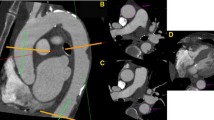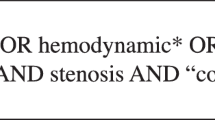Abstract
Coronary artery disease (CAD) risk and plaque scores are often subjective and biased, particularly in mid-age asymptomatic women, whose CAD risk assessment has been historically underestimated. In this study, a new automatic ascending aorta time-to-peak-distention (TPD) analysis was developed for fast screening and as an independent surrogate for subclinical atherosclerosis in asymptomatic women. CCTA was obtained in 50 asymptomatic adults. Plaque burden segment involvement score (SIS) and automatic TPD were obtained from all subjects. Logistic regression analyses were performed to investigate the association between CAD risk scores and TPD with severe coronary plaque burden (SIS>5). TPD, individually, was found to be a significant predictor of SIS>5. Additionally, sex was a significant effect modifier of TPD, with a stronger statistically significant association with women. Four-dimensional aortic time-to-peak distention could supplement conventional CCTA analysis and offer a quick objective screening tool for plaque burden severity and CAD risk stratification, especially in women.
Graphical Abstract



Similar content being viewed by others
Abbreviations
- CAD:
-
Coronary artery disease
- CCTA:
-
Coronary computed tomography angiography
- MDCT:
-
Multi-detector computed tomography
- AA:
-
Ascending aorta
- TPD:
-
Time to peak distensibility
- ROC:
-
Receiver operator curve
- FrS:
-
Framingham score
- ASCVD:
-
Atherosclerotic cardiovascular disease pooled cohort equation score
- SIS:
-
Segment involvement score
- AD:
-
Aortic distensibility
- ECG:
-
Electrocardiograph
- AoAd:
-
Diastolic aortic cross-sectional area
- AoAs:
-
Systolic aortic cross-sectional area
- Ps:
-
Systolic blood pressure
- Pd:
-
Diastolic blood pressure
- PWV:
-
Pulse wave velocity
- IQR:
-
Interquartile range
- SD:
-
Standard deviation
- CVD:
-
Cardiovascular disease
References
Goff DC Jr, Lloyd-Jones DM, Bennett G, Coady S, D'Agostino RB Sr, Gibbons R, et al. ACC/AHA guideline on the assessment of cardiovascular risk: a report of the American College of Cardiology/American Heart Association Task Force on Practice Guidelines. J Am Coll Cardiol. 2014;63(25 Pt B):2935–59. https://doi.org/10.1016/j.jacc.2013.11.005.
Michos ED, Nasir K, Braunstein JB, Rumberger JA, Budoff MJ, Post WS, et al. Framingham risk equation underestimates subclinical atherosclerosis risk in asymptomatic women. Atherosclerosis. 2006;184(1):201–6. https://doi.org/10.1016/j.atherosclerosis.2005.04.004.
Gulati M, Shaw LJ, Bairey Merz CN. Myocardial ischemia in women: lessons from the NHLBI WISE study. Clin Cardiol. 2012;35(3):141–8. https://doi.org/10.1002/clc.21966.
Wilmot KA, O'Flaherty M, Capewell S, Ford ES, Vaccarino V. Coronary heart disease mortality declines in the United States from 1979 through 2011: evidence for stagnation in young adults, especially women. Circulation. 2015;132(11):997–1002. https://doi.org/10.1161/CIRCULATIONAHA.115.015293.
Johnson KM, Dowe DA. The detection of any coronary calcium outperforms Framingham risk score as a first step in screening for coronary atherosclerosis. AJR Am J Roentgenol. 2010;194(5):1235–43. https://doi.org/10.2214/AJR.09.2487.
Raggi P, Shaw LJ, Berman DS, Callister TQ. Gender-based differences in the prognostic value of coronary calcification. J Womens Health. 2004;13(3):273–83. https://doi.org/10.1089/154099904323016437.
Redheuil A, Wu CO, Kachenoura N, Ohyama Y, Yan RT, Bertoni AG, et al. Proximal aortic distensibility is an independent predictor of all-cause mortality and incident CV events: the MESA study. J Am Coll Cardiol. 2014;64(24):2619–29. https://doi.org/10.1016/j.jacc.2014.09.060.
Nichols WW, Denardo SJ, Davidson JB, Huo T, Bairey Merz CN, Pepine CJ. Association of aortic stiffness and wave reflections with coronary flow reserve in women without obstructive coronary artery disease: an ancillary study from the National Heart, Lung, and Blood Institute-sponsored Women’s Ischemia Syndrome Evaluation (WISE). Am Heart J. 2015;170(6):1243–54. https://doi.org/10.1016/j.ahj.2015.08.019.
Siegel E, Thai WE, Techasith T, Major G, Szymonifka J, Tawakol A, et al. Aortic distensibility and its relationship to coronary and thoracic atherosclerosis plaque and morphology by MDCT: insights from the ROMICAT trial. Int J Cardiol. 2013;167(4):1616–21. https://doi.org/10.1016/j.ijcard.2012.04.107.
Ahmadi N, Nabavi V, Hajsadeghi F, Flores F, Azmoon S, Ismaeel H, et al. Impaired aortic distensibility measured by computed tomography is associated with the severity of coronary artery disease. Int J Cardiovasc Imaging. 2011;27(3):459–69. https://doi.org/10.1007/s10554-010-9680-6.
Okuyama T, Ehara S, Shirai N, Sugioka K, Yamashita H, Kataoka T, et al. Assessment of aortic atheromatous plaque and stiffness by 64-slice computed tomography is useful for identifying patients with coronary artery disease. Circ J. 2008;72(12):2021–7. https://doi.org/10.1253/circj.cj-08-0396.
Nichols WW, O'Rourke MF, Edelman ER, Vlachopoulos C. McDonald's blood flow in arteries : theoretical, experimental and clinical principles. Seventh edition. ed. Boca Raton, FL: CRC Press; 2022.
Hashimoto J, Ito S. Aortic stiffness determines diastolic blood flow reversal in the descending thoracic aorta: potential implication for retrograde embolic stroke in hypertension. Hypertension. 2013;62(3):542–9. https://doi.org/10.1161/HYPERTENSIONAHA.113.01318.
O'Rourke MF, Hashimoto J. Mechanical factors in arterial aging: a clinical perspective. J Am Coll Cardiol. 2007;50(1):1–13. https://doi.org/10.1016/j.jacc.2006.12.050.
Dyverfeldt P, Bissell M, Barker AJ, Bolger AF, Carlhall CJ, Ebbers T, et al. 4D flow cardiovascular magnetic resonance consensus statement. J Cardiovasc Magn Reson. 2015;17(1):72. https://doi.org/10.1186/s12968-015-0174-5.
Zhang J, Fletcher JG, Vrtiska TJ, Manduca A, Thompson JL, Raghavan ML, et al. Large-vessel distensibility measurement with electrocardiographically gated multidetector CT: phantom study and initial experience. Radiology. 2007;245(1):258–66. https://doi.org/10.1148/radiol.2451060530.
Min JK, Dunning A, Lin FY, Achenbach S, Al-Mallah M, Budoff MJ, et al. Age- and sex-related differences in all-cause mortality risk based on coronary computed tomography angiography findings results from the International Multicenter CONFIRM (Coronary CT Angiography Evaluation for Clinical Outcomes: An International Multicenter Registry) of 23,854 patients without known coronary artery disease. J Am Coll Cardiol. 2011;58(8):849–60. https://doi.org/10.1016/j.jacc.2011.02.074.
Magnoni M, Andreini D, Gorini M, Moccetti T, Modena MG, Canestrari M, et al. Coronary atherosclerosis in outlier subjects at the opposite extremes of traditional risk factors: rationale and preliminary results of the Coronary Atherosclerosis in outlier subjects: Protective and novel Individual Risk factors Evaluation (CAPIRE) study. Am Heart J. 2016;173:18–26. https://doi.org/10.1016/j.ahj.2015.11.017.
Ghanem AM, Hamimi AH, Matta JR, Carass A, Elgarf RM, Gharib AM, et al. Automatic coronary wall and atherosclerotic plaque segmentation from 3D coronary CT angiography. Sci Rep. 2019;9(1):47. https://doi.org/10.1038/s41598-018-37168-4.
Peduzzi P, Concato J, Kemper E, Holford TR, Feinstein AR. A simulation study of the number of events per variable in logistic regression analysis. J Clin Epidemiol. 1996;49(12):1373–9. https://doi.org/10.1016/s0895-4356(96)00236-3.
Rylski B, Desjardins B, Moser W, Bavaria JE, Milewski RK. Gender-related changes in aortic geometry throughout life. Eur J Cardiothorac Surg. 2014;45(5):805–11. https://doi.org/10.1093/ejcts/ezt597.
Chang HW, Kim SH, Hakim AR, Chung S, Kim DJ, Lee JH, et al. Diameter and growth rate of the thoracic aorta-analysis based on serial computed tomography scans. J Thorac Dis. 2020;12(8):4002–13. https://doi.org/10.21037/jtd-20-1275.
Crea F, Battipaglia I, Andreotti F. Sex differences in mechanisms, presentation and management of ischaemic heart disease. Atherosclerosis. 2015;241(1):157–68. https://doi.org/10.1016/j.atherosclerosis.2015.04.802.
Mileto A, Heye TJ, Makar RA, Hurwitz LM, Marin D, Boll DT. Regional mapping of aortic wall stress by using deformable, motion-coherent modeling based on electrocardiography-gated multidetector CT angiography: feasibility study. Radiology. 2016;280(1):230–6. https://doi.org/10.1148/radiol.2015151078.
Cecchi E, Giglioli C, Valente S, Lazzeri C, Gensini GF, Abbate R, et al. Role of hemodynamic shear stress in cardiovascular disease. Atherosclerosis. 2011;214(2):249–56. https://doi.org/10.1016/j.atherosclerosis.2010.09.008.
Gijsen F, van der Giessen A, van der Steen A, Wentzel J. Shear stress and advanced atherosclerosis in human coronary arteries. J Biomech. 2013;46(2):240–7. https://doi.org/10.1016/j.jbiomech.2012.11.006.
Coutinho T. Arterial stiffness and its clinical implications in women. Can J Cardiol. 2014;30(7):756–64. https://doi.org/10.1016/j.cjca.2014.03.020.
Coutinho T, Borlaug BA, Pellikka PA, Turner ST, Kullo IJ. Sex differences in arterial stiffness and ventricular-arterial interactions. J Am Coll Cardiol. 2013;61(1):96–103. https://doi.org/10.1016/j.jacc.2012.08.997.
Coutinho T, Yam Y, Chow BJW, Dwivedi G, Inacio J. Sex differences in associations of arterial compliance with coronary artery plaque and calcification burden. J Am Heart Assoc. 2017;6(8) https://doi.org/10.1161/JAHA.117.006079.
Coutinho T, Mielniczuk LM, Srivaratharajah K, deKemp R, Wells GA, Beanlands RS. Coronary artery microvascular dysfunction: role of sex and arterial load. Int J Cardiol. 2018;270:42–7. https://doi.org/10.1016/j.ijcard.2018.06.072.
Gatzka CD, Cameron JD, Kingwell BA, Dart AM. Relation between coronary artery disease, aortic stiffness, and left ventricular structure in a population sample. Hypertension. 1998;32(3):575–8. https://doi.org/10.1161/01.hyp.32.3.575.
Weber T, Auer J, O'Rourke MF, Kvas E, Lassnig E, Berent R, et al. Arterial stiffness, wave reflections, and the risk of coronary artery disease. Circulation. 2004;109(2):184–9. https://doi.org/10.1161/01.CIR.0000105767.94169.E3.
Segers P, Rietzschel ER, De Buyzere ML, Vermeersch SJ, De Bacquer D, Van Bortel LM, et al. Noninvasive (input) impedance, pulse wave velocity, and wave reflection in healthy middle-aged men and women. Hypertension. 2007;49(6):1248–55. https://doi.org/10.1161/HYPERTENSIONAHA.106.085480.
Bugiardini R, Badimon L, Collins P, Erbel R, Fox K, Hamm C, et al. Angina, “normal” coronary angiography, and vascular dysfunction: risk assessment strategies. PLoS Med. 2007;4(2):e12. https://doi.org/10.1371/journal.pmed.0040012.
Ghanem AM, Matta JR, Elgarf R, Hamimi A, Muniyappa R, Ishaq H, et al. Sexual dimorphism of coronary artery disease in a low- and intermediate-risk asymptomatic population: association with coronary vessel wall thickness at MRI in women. Radiol Cardiothorac Imaging. 2019;1(1):e180007. https://doi.org/10.1148/ryct.2019180007.
Pasupathy S, Air T, Dreyer RP, Tavella R, Beltrame JF. Systematic review of patients presenting with suspected myocardial infarction and nonobstructive coronary arteries. Circulation. 2015;131(10):861–70. https://doi.org/10.1161/CIRCULATIONAHA.114.011201.
Dean J, Cruz SD, Mehta PK, Merz CN. Coronary microvascular dysfunction: sex-specific risk, diagnosis, and therapy. Nat Rev Cardiol. 2015;12(7):406–14. https://doi.org/10.1038/nrcardio.2015.72.
Yoshino S, Cilluffo R, Prasad M, Best PJ, Atkinson EJ, Aoki T, et al. Sex-specific genetic variants are associated with coronary endothelial dysfunction. J Am Heart Assoc. 2016;5(4):e002544. https://doi.org/10.1161/JAHA.115.002544.
Ayoub C, Erthal F, Abdelsalam MA, Murad MH, Wang Z, Erwin PJ, et al. Prognostic value of segment involvement score compared to other measures of coronary atherosclerosis by computed tomography: a systematic review and meta-analysis. J Cardiovasc Comput Tomogr. 2017;11(4):258–67. https://doi.org/10.1016/j.jcct.2017.05.001.
Szilveszter B, Kolossvary M, Pontone G, Williams MC, Dweck MR, Maurovich-Horvat P. How to quantify coronary atherosclerotic plaque using computed tomography. Eur Heart J Cardiovasc Imaging. 2022;23(12):1573–5. https://doi.org/10.1093/ehjci/jeac192.
Pen A, Yam Y, Chen L, Dennie C, McPherson R, Chow BJ. Discordance between Framingham risk score and atherosclerotic plaque burden. Eur Heart J. 2013;34(14):1075–82. https://doi.org/10.1093/eurheartj/ehs473.
Li F, Wang X. Relationship between Framingham risk score and subclinical atherosclerosis in carotid plaques: an in vivo study using multi-contrast MRI. Sci China Life Sci. 2017;60(1):23–7. https://doi.org/10.1007/s11427-016-0385-5.
Seaoud E, Shawky A. Framingham risk score and extent of atherosclerosis in non-diabetic patients with suspected coronary artery disease. J Indian Coll Cardiol. 2018;8(1):18–20. https://doi.org/10.1016/j.jicc.2017.12.001.
Min JK, Shaw LJ, Devereux RB, Okin PM, Weinsaft JW, Russo DJ, et al. Prognostic value of multidetector coronary computed tomographic angiography for prediction of all-cause mortality. J Am Coll Cardiol. 2007;50(12):1161–70. https://doi.org/10.1016/j.jacc.2007.03.067.
Acknowledgements
The authors thank the participants for their time and contribution to this research endeavor.
Funding
This work was supported by the Intramural Research Program of the National Institute of Diabetes, Digestive, and Kidney Diseases at the National Institutes of Health.
Author information
Authors and Affiliations
Corresponding authors
Ethics declarations
Human Subjects/Informed Consent
All procedures followed were in accordance with the ethical standards of the responsible committee on human experimentation (institutional and national) and with the Helsinki Declaration of 1975, as revised in 2000. Informed consent was obtained from all patients for being included in the study.
Conflict of Interest
The authors declare no competing interests.
Additional information
Associate Editor Jozine ter Maaten oversaw the review of this article
Publisher’s Note
Springer Nature remains neutral with regard to jurisdictional claims in published maps and institutional affiliations.
Khaled Z. Abd-Elmoniem is the lead author.
Rights and permissions
About this article
Cite this article
Hamimi, A.H., Ghanem, A.M., Hannah-Shmouni, F. et al. Ascending Aorta 4D Time to Peak Distention Sexual Dimorphism and Association with Coronary Plaque Burden Severity in Women. J. of Cardiovasc. Trans. Res. 17, 298–307 (2024). https://doi.org/10.1007/s12265-023-10422-5
Received:
Accepted:
Published:
Issue Date:
DOI: https://doi.org/10.1007/s12265-023-10422-5




